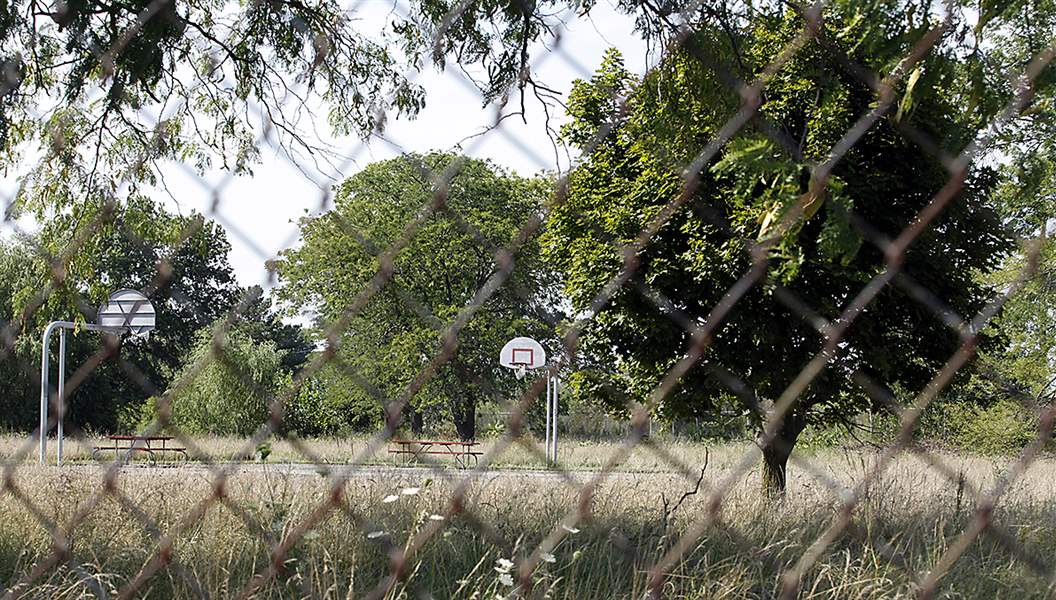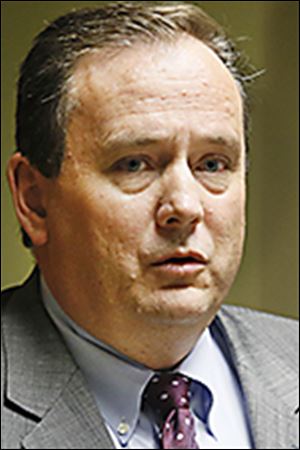
Whirlpool contractor exonerates Clyde site
Study finds no link to ex-park, cancer clusters
11/1/2013
Testing of the former Whirlpool Park found high levels of contaminants in soil near basketball courts and the park's old grist mill.
THE BLADE
Buy This Image

Testing of the former Whirlpool Park found high levels of contaminants in soil near basketball courts and the park's old grist mill.

Mortensen
CLYDE, Ohio — Whirlpool Corp. feels exonerated by testing performed by a company contractor that — according to the company — shows no evidence of illegal dumping in or widespread contamination of the 27-acre site near Green Springs formerly known as Whirlpool Park, a company official said Thursday.
“We’re satisfied all of the testing validates that there’s no health concerns,” D. Jeffrey Noel, Whirlpool’s vice president for communications and public affairs, told The Blade during an interview in Toledo.
“In effect, we found nothing surprising,” he added.
From Whirlpool’s point of view, that’s good news.
Although questions remain over what has caused eastern Sandusky County’s rare childhood-cancer cluster, Mr. Noel said the findings should give area residents and Whirlpool employees peace of mind about that site.
Whirlpool had owned the site for decades and had made it available as a community park.
It is now privately owned by a company deciding whether to build housing on it.

The company’s statements are based on a 1,608-page report prepared by its contractor, AECOM Technical Services.
High levels of polychlorinated biphenyls, or PCBs, were found in soil near basketball courts and the park’s old grist mill.
But PCBs, common industrial lubricants that were widely used until scientists linked them to cancer in the 1970s, are pervasive in old fill.
Fill was brought in during the 1950s and 1960s to those sections of the park to level them out as the facility was being built and improved.
The contaminants there may have been embedded in that soil, Mr. Noel said.
None of the groundwater beneath the park nor its pool filters were contaminated. The pool is where people likely would have had the most direct contact with the site, Mr. Noel said.
The U.S. Environmental Protection Agency has not cleared Whirlpool.
But the agency said in a statement Thursday that “we concur with the company's environmental assessment findings.”
Throughout the day, it referred questions to a letter dated Wednesday and signed by Stephen Wolfe, an agency on-scene coordinator, which provided no analysis of the results but affirmed that Whirlpool's testing protocol met stipulations outlined in an earlier agreement.
Neither Mr. Wolfe nor his supervisor, Mark Durno, were available for comment. The agency’s public affairs department declined to comment.
“I just hope this is not a press release from the fox saying the henhouse is clean,” said Alan Mortensen, a Utah attorney representing several Clyde-area families in a federal lawsuit.
Whirlpool noted in its three-page executive summary that PCBs were found below the former pool’s floor, which was first sealed in 1956.
However, it said concentrations were too low to endanger human health.
Mr. Mortensen said families would like to do their own independent testing of the site.
Whirlpool said it split samples it drew from the site with the U.S. EPA. The company analyzed 328 samples for 232 chemical compounds, Mr. Noel said.
“We understand where the families are coming from. We have great empathy for the families,” he said. “Our issue is with attorneys who have used no science, no fact.”
Mr. Mortensen’s firm cited Whirlpool Park in its lawsuit against Whirlpool, claiming it should have been investigated years ago. The federal EPA went there after receiving tips about it on an agency hotline from people who claimed to have information about illegal dumping of chemical waste there.
The attorney last night provided The Blade with a statement urging further study.
In the statement, he said attorneys and experts representing the cancer victims believe Whirlpool’s conclusions need to be examined in more detail.
He described data about PCBs near the old grist mill as “a new finding.”
“Whirlpool tries to gloss over the findings of PCBs at the grist mill by referring to the PCBs at the basketball court having been earlier discovered,” Mr. Mortensen stated in his release.
The statement cites sections of the report not in the company’s executive summary, such as one carcinogen, benzo(a)pyrene, found at a concentration 86 times above the acceptable level for human exposure.
“The victims alleged in their lawsuit that benzo(a)pyrene was one of the causes of the Clyde cancer cluster as it has been found at other Whirlpool dumping sites in eastern Sandusky County. The Whirlpool Park findings of benzo(a)pyrene shows a consistency at what is found at the Whirlpool dump sites,” according to Mr. Mortensen’s statement.
Two other contaminants, benzo(a)anthracene, and benzo(b)fluoranthene, were found at levels of 12 and nine times beyond the acceptable levels, respectively, Mr. Mortensen’s statement said.
Indeno(1,2,3-cd)pyrene, which also is a suspected human carcinogen, was found at a concentration three times greater than acceptable, the statement said.
“Given the tone of the executive summary, the victims believe that Whirlpool would have no issues with an independent confirmation at the Whirlpool Park by the victims’ team of experts,” Mr. Mortensen wrote.
Two fathers who have had children stricken by cancer — Sandusky County Administrator Warren Brown and Dan Hisey, manager of a Clyde supermarket — said they were advised by attorneys to withhold comments for the time being.
Contact Tom Henry at: thenry@theblade.com or 419-724-6079.